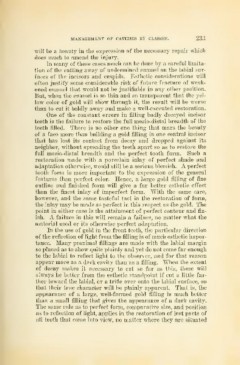Page 477 - My FlipBook
P. 477
MANAGEMENT OF CAVITIES BY CLASSES. 233
will be a beauty in the expression of the necessary repair -whicb
does much to amend the injury.
In many of these cases much can be done by a careful limita-
tion of the cutting away of undermined enamel on the labial sur-
faces of the incisors and cuspids. Esthetic considerations will
often justify some considerable risk of future fracture of weak-
ened enamel that would not be justifiable in any other position.
But, when the enamel is so thin and so transparent that the yel-
low color of gold will show through it, the result will be worse
than to cut it boldly away and make a well-executed restoration.
One of the constant errors in filling badly decayed incisor
teeth is the failure to restore the full mesio-distal breadth of the
teeth filled. There is no other one thing that mars the beauty
of a face more than building a gold filling in one central incisor
that has lost its contact from decay and dropped against its
neighbor, without spreading the teeth apart so as to restore the
full mesio-distal breadth and the perfect tooth form. Such a
restoration made with a porcelain inlay of perfect shade and
adaptation otherwise, would still be a serious blemish. A perfect
tooth form is more important to the expression of the general
features than perfect color. Hence, a large gold filling of fine
outline and finished form will give a far better esthetic effect
than the finest inlay of imperfect form. With the same care,
however, and the same tasteful tact in the restoration of form,
the inlay may be made as perfect in this respect as the gold. The
point in either case is the attainment of perfect contour and fin-
ish. A failure in this will remain a failure, no matter what the
material used or its otherwise perfect adaptation.
In the use of gold in the front teeth, the particular direction
of the reflection of light from the filling is of much esthetic impor-
tance. Many proximal fillings are made with the labial margin
so placed as to show quite plainly and yet do not come far enough
to the labial to reflect light to the observer, and for that reason
appear more as a dark cavity than as a filling. When the extent
of decay makes it necessary to cut so far as this, these will
always be better from the esthetic standpoint if cut a little far-
ther toward the labial, or a trifle over onto the labial surface, so
that their true character will be plainly apparent. That is, the
appearance of a large, well-formed gold filling is much better
than a small filling that gives the appearance of a dark cavity.
The same rule as to perfect form, comparative size, and position
as to reflection of light, applies in the restoration of lost parts of
all teeth that come into view, no matter where they are situated


